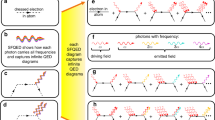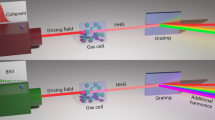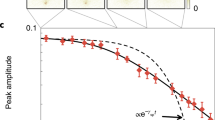Abstract
Strongly driven systems of emitters offer an attractive source of light over broad spectral ranges up to the X-ray region. A key limitation of these systems is that the light they emit is mostly classical. We overcome this constraint by building a quantum-optical theory of strongly driven many-body systems, showing that the presence of correlations among the emitters creates emission of non-classical many-photon states of light. We consider the example of high-harmonic generation, by which a strongly driven system emits photons at integer multiples of the drive frequency. In the conventional case of uncorrelated emitters, the harmonics are in an almost perfectly multi-mode coherent state lacking any correlation between harmonics. By contrast, a correlation of the emitters before the strong drive is converted into non-classical features of the output light, including doubly peaked photon statistics, ring-shaped Wigner functions and correlations between harmonics. We propose schemes for implementing these concepts, creating the correlations between emitters via an interaction between them or their joint interaction with the background electromagnetic field. Our work paves the way towards the engineering of novel states of light over a broadband spectrum and suggests high-harmonic generation as a tool for characterizing correlations in many-body systems with attosecond temporal resolution.
This is a preview of subscription content, access via your institution
Access options
Access Nature and 54 other Nature Portfolio journals
Get Nature+, our best-value online-access subscription
$29.99 / 30 days
cancel any time
Subscribe to this journal
Receive 12 print issues and online access
$209.00 per year
only $17.42 per issue
Buy this article
- Purchase on Springer Link
- Instant access to full article PDF
Prices may be subject to local taxes which are calculated during checkout





Similar content being viewed by others
Data availability
All the data that support the plots within this paper and other findings of this study are available from the corresponding author upon reasonable request.
Code availability
The code is available from the authors upon reasonable request.
References
Mukamel, S. et al. Roadmap on quantum light spectroscopy. J. Phys. B 53, 72002 (2020).
Aasi, J. et al. Enhanced sensitivity of the LIGO gravitational wave detector by using squeezed states of light. Nat. Photonics 7, 613–619 (2013).
Aasi, J. et al. Advanced LIGO. Class. Quantum Gravity 32, 74001 (2015).
Arrazola, J. M. et al. Quantum circuits with many photons on a programmable nanophotonic chip. Nature 591, 54–60 (2021).
Wu, L.-A., Kimble, H. J., Hall, J. L. & Wu, H. Generation of squeezed states by parametric down conversion. Phys. Rev. Lett. 57, 2520 (1986).
Pereira, S. F., Xiao, M., Kimble, H. J. & Hall, J. L. Generation of squeezed light by intracavity frequency doubling. Phys. Rev. A 38, 4931 (1988).
Breitenbach, G., Schiller, S. & Mlynek, J. Measurement of the quantum states of squeezed light. Nature 387, 471–475 (1997).
Agafonov, I. N., Chekhova, M. V. & Leuchs, G. Two-color bright squeezed vacuum. Phys. Rev. A 82, 11801 (2010).
Iskhakov, T. S., Pérez, A. M., Spasibko, K. Y., Chekhova, M. V. & Leuchs, G. Superbunched bright squeezed vacuum state. Opt. Lett. 37, 1919 (2012).
Spasibko, K. Y. et al. Multiphoton effects enhanced due to ultrafast photon-number fluctuations. Phys. Rev. Lett. 119, 223603 (2017).
Manceau, M., Spasibko, K. Y., Leuchs, G., Filip, R. & Chekhova, M. V. Indefinite-mean Pareto photon distribution from amplified quantum noise. Phys. Rev. Lett. 123, 123606 (2019).
Zavatta, A., Viciani, S. & Bellini, M. Quantum-to-classical transition with single-photon-added coherent states of light. Science 306, 660 (2004).
Ourjoumtsev, A., Tualle-Brouri, R., Laurat, J. & Grangier, P. Generating optical Schrodinger kittens for quantum information processing. Science 312, 83 (2006).
Lewenstein, M. et al. Generation of optical Schrödinger cat states in intense laser–matter interactions. Nat. Phys. 17, 1104–1108 (2021).
Ourjoumtsev, A., Jeong, H., Tualle-Brouri, R. & Grangier, P. Generation of optical ‘Schrödinger cats’ from photon number states. Nature 448, 784–786 (2007).
Sychev, D. V. et al. Enlargement of optical Schrödinger’s cat states. Nat. Photonics 11, 379–382 (2017).
Wakui, K., Takahashi, H., Furusawa, A. & Sasaki, M. Photon subtracted squeezed states generated with periodically poled KTiOPO4. Opt. Express 15, 3568 (2007).
Deleglise, S. et al. Reconstruction of non-classical cavity field states with snapshots of their decoherence. Nature 455, 510–514 (2008).
Paul, P.-M. et al. Observation of a train of attosecond pulses from high harmonic generation. Science 292, 1689 (2001).
Agostini, P. & DiMauro, L. F. The physics of attosecond light pulses. Rep. Prog. Phys. 67, 813 (2004).
Corkum, P. B. Plasma perspective on strong field multiphoton ionization. Phys. Rev. Lett. 71, 1994 (1993).
Lewenstein, M., Balcou, P., Ivanov, M. Y., L’Huillier, A. & Corkum, P. B. Theory of high-harmonic generation by low-frequency laser fields. Phys. Rev. A 49, 2117 (1994).
Schafer, K. J., Yang, B., DiMauro, L. F. & Kulander, K. C. Above threshold ionization beyond the high harmonic cutoff. Phys. Rev. Lett. 70, 1599 (1993).
Tsatrafyllis, N., Kominis, I. K., Gonoskov, I. A. & Tzallas, P. High-order harmonics measured by the photon statistics of the infrared driving-field exiting the atomic medium. Nat. Commun. 8, 15170 (2017).
Tsatrafyllis, N. et al. Quantum optical signatures in a strong laser pulse after interaction with semiconductors. Phys. Rev. Lett. 122, 193602 (2019).
Gorlach, A., Neufeld, O., Rivera, N., Cohen, O. & Kaminer, I. The quantum-optical nature of high harmonic generation. Nat. Commun. 11, 4598 (2020).
Mandel, L. & Wolf, E. Optical Coherence and Quantum Optics (Cambridge Univ. Press, 1995).
Scully, M. O. & Zubairy, M. S. Quantum Optics (Cambridge Univ. Press, 1997).
Gerry, C., Knight, P., & Knight, P. L. Introductory Quantum Optics (Cambridge Univ. Press, 2005).
Garrison, J. & Chiao, R. Quantum Optics (Oxford Univ. Press, 2008).
Dicke, R. H. Coherence in spontaneous radiation processes. Phys. Rev. 93, 99 (1954).
Gross, M. & Haroche, S. Superradiance: an essay on the theory of collective spontaneous emission. Phys. Rep. 93, 301 (1982).
Kitagawa, M. & Ueda, M. Squeezed spin states. Phys. Rev. A 47, 5138 (1993).
Kardar, M. Statistical Physics of Fields (Cambridge Univ. Press, 2007).
Kardar, M. Statistical Physics of Particles (Cambridge Univ. Press, 2007).
Brabec, T. & Kapteyn, H. Strong Field Laser Physics, Vol. 1 (Springer, 2008).
Boyd, R. W. Nonlinear Optics (Academic, 2020).
Vrakking, M. & Schultz, T. Attosecond and XUV Physics: Ultrafast Dynamics and Spectroscopy (Wiley Online Library, 2014).
Dowling, J. P., Agarwal, G. S. & Schleich, W. P. Wigner distribution of a general angular-momentum state: applications to a collection of two-level atoms. Phys. Rev. A 49, 4101 (1994).
Joachain, C. J., Kylstra, N. J., & Potvliege, R. M. Atoms in Intense Laser Fields (Cambridge Univ. Press, 2012).
Nurhuda, M. & Faisal, F. H. M. Numerical solution of time-dependent Schrödinger equation for multiphoton processes: a matrix iterative method. Phys. Rev. A 60, 3125 (1999).
Gardiner, C., Zoller, P., and Zoller, P. Quantum Noise: A Handbook of Markovian and Non-Markovian Quantum Stochastic Methods with Applications to Quantum Optics (Springer Science & Business Media, 2004).
Porras, D. & Cirac, J. I. Collective generation of quantum states of light by entangled atoms. Phys. Rev. A 78, 53816 (2008).
McCaul, G., Orthodoxou, C., Jacobs, K., Booth, G. H. & Bondar, D. I. Driven imposters: controlling expectations in many-body systems. Phys. Rev. Lett. 124, 183201 (2020).
Paulisch, V., Perarnau-Llobet, M., González-Tudela, A. & Cirac, J. I. Quantum metrology with one-dimensional superradiant photonic states. Phys. Rev. A 99, 43807 (2019).
Witek, H., Cardoso, V., Ishibashi, A. & Sperhake, U. Superradiant instabilities in astrophysical systems. Phys. Rev. D. 87, 43513 (2013).
Bonifacio, R., Schwendimann, P. & Haake, F. Quantum statistical theory of superradiance. I. Phys. Rev. A 4, 302 (1971).
Bonifacio, R., Schwendimann, P. & Haake, F. Quantum statistical theory of superradiance II. Phys. Rev. A 4, 854 (1971).
Muniz, J. A. et al. Exploring dynamical phase transitions with cold atoms in an optical cavity. Nature 580, 602–607 (2020).
Bernien, H. et al. Probing many-body dynamics on a 51-atom quantum simulator. Nature 551, 579–584 (2017).
Lvovsky, A. I. & Raymer, M. G. Continuous-variable optical quantum-state tomography. Rev. Mod. Phys. 81, 299 (2009).
Smithey, D. T., Beck, M., Raymer, M. G. & Faridani, A. Measurement of the Wigner distribution and the density matrix of a light mode using optical homodyne tomography: application to squeezed states and the vacuum. Phys. Rev. Lett. 70, 1244 (1993).
Leonhardt, U. Measuring the Quantum State of Light, Vol. 22 (Cambridge Univ. Press, 1997).
Descamps, D. et al. Extreme ultraviolet interferometry measurements with high-order harmonics. Opt. Lett. 25, 135–137 (2000).
Dudovich, N. et al. Measuring and controlling the birth of attosecond XUV pulses. Nat. Phys. 2, 781–786 (2006).
Smirnova, O. et al. High harmonic interferometry of multi-electron dynamics in molecules. Nature 460, 972–977 (2009).
Comby, A. et al. Absolute gas density profiling in high-order harmonic generation. Opt. Express 26, 6001 (2018).
Ghimire, S. et al. Observation of high-order harmonic generation in a bulk crystal. Nat. Phys. 7, 138–141 (2011).
Tancogne-Dejean, N., Mücke, O. D., Kärtner, F. X. & Rubio, A. Ellipticity dependence of high-harmonic generation in solids originating from coupled intraband and interband dynamics. Nat. Commun. 8, 745 (2017).
Ghimire, S. & Reis, D. A. High-harmonic generation from solids. Nat. Phys. 15, 10–16 (2019).
Sørensen, A. S. & Mølmer, K. Entangling atoms in bad cavities. Phys. Rev. A 66, 22314 (2002).
Zibrov, A. S., Ye, C. Y., Rostovtsev, Y. V., Matsko, A. B. & Scully, M. O. Observation of a three-photon electromagnetically induced transparency in hot atomic vapor. Phys. Rev. A 65, 43817 (2002).
Ritsch, H., Domokos, P., Brennecke, F. & Esslinger, T. Cold atoms in cavity-generated dynamical optical potentials. Rev. Mod. Phys. 85, 553 (2013).
Perlin, M. A., Qu, C. & Rey, A. M. Spin squeezing with short-range spin-exchange interactions. Phys. Rev. Lett. 125, 223401 (2020).
Ma, J., Wang, X., Sun, C.-P. & Nori, F. Quantum spin squeezing. Phys. Rep. 509, 89 (2011).
Gallagher, T. F., Rydberg Atoms, Vol. 3 (Cambridge Univ. Press, 2005).
Omran, A. et al. Generation and manipulation of Schrödinger cat states in Rydberg atom arrays. Science 365, 570 (2019).
Browaeys, A. & Lahaye, T. Many-body physics with individually controlled Rydberg atoms. Nat. Phys. 16, 132–142 (2020).
Lloyd, S. Enhanced sensitivity of photodetection via quantum illumination. Science 321, 1463 (2008).
Sayre, D., Kirz, J., Feder, R., Kim, D. M. & Spiller, E. Potential operating region for ultrasoft X-ray microscopy of biological materials. Science 196, 1339 (1977).
Harada, K. et al. Real-time observation of vortex lattices in a superconductor by electron microscopy. Nature 360, 51–53 (1992).
Abo-Shaeer, J. R., Raman, C., Vogels, J. M. & Ketterle, W. Observation of vortex lattices in Bose–Einstein condensates. Science 292, 476 (2001).
Acknowledgements
We thank R. Bekenstein, O. Cohen, E. G. Dalla Torre, M. Even Tzur, M. Faran, R. Ruimy, E. Shahmoon and J. Sloan for insightful discussion on related topics and especially D. Malz and M. Kruger for discussions and for comments on the manuscript, and M. E. Tsur for illustrating state-of-the-art methods for simulating HHG with one-dimensional atomic models. A.P. acknowledges support from the Royal Society and from the AFOSR MURI programme (grant no. FA9550-21-1-0069), and hospitality at the Technical University of Munich (TUM).
Author information
Authors and Affiliations
Contributions
All the authors made critical contributions to this work.
Corresponding authors
Ethics declarations
Competing interests
The authors declare no competing interests.
Peer review
Peer review information
Nature Physics thanks Karen Hatsagortsyan and the other, anonymous, reviewer(s) for their contribution to the peer review of this work.
Additional information
Publisher’s note Springer Nature remains neutral with regard to jurisdictional claims in published maps and institutional affiliations.
Supplementary information
Supplementary Information
Supplementary Sects. S1–S8 and Figs. 1–8.
Rights and permissions
Springer Nature or its licensor (e.g. a society or other partner) holds exclusive rights to this article under a publishing agreement with the author(s) or other rightsholder(s); author self-archiving of the accepted manuscript version of this article is solely governed by the terms of such publishing agreement and applicable law.
About this article
Cite this article
Pizzi, A., Gorlach, A., Rivera, N. et al. Light emission from strongly driven many-body systems. Nat. Phys. 19, 551–561 (2023). https://doi.org/10.1038/s41567-022-01910-7
Received:
Accepted:
Published:
Issue Date:
DOI: https://doi.org/10.1038/s41567-022-01910-7
This article is cited by
-
Multiphoton electron emission with non-classical light
Nature Physics (2024)
-
High-harmonic generation driven by quantum light
Nature Physics (2023)
-
Photon-statistics force in ultrafast electron dynamics
Nature Photonics (2023)
-
Quantum correlated atoms in intense laser fields
Nature Physics (2023)



